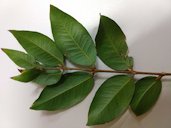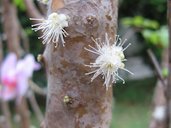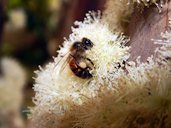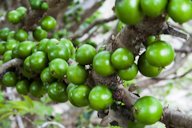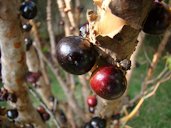| Jaboticaba - Myrciaria cauliflora | |||||||||||||||||||||||||||||||||||
|---|---|---|---|---|---|---|---|---|---|---|---|---|---|---|---|---|---|---|---|---|---|---|---|---|---|---|---|---|---|---|---|---|---|---|---|
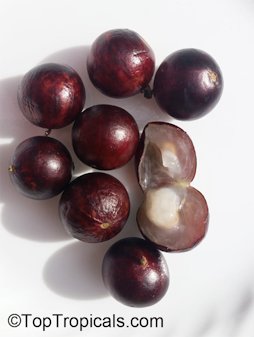 Fig. 1  Myrciaria cauliflora, Plinia cauliflora, Eugenia cauliflora 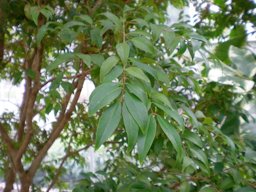 Fig. 6   Fig. 7  M. cauliflora (Jaboticaba, Brazilian grape tree), leaves, Makawao, Maui, Hawai'i 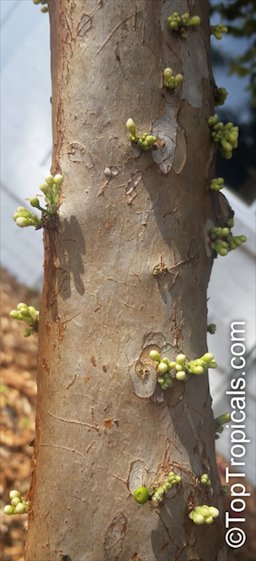 Fig. 9  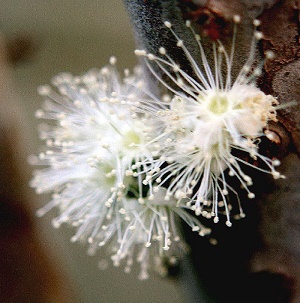 Fig. 10  Jabuticaba flowers - Side by Side, Brazil  Fig. 11   Fig. 12  Happy Quinta-flower! Jabuticaba - M. cauliflora. Fruit native to Brazil, bears stem berries, purple in color and absolutely delicious!  Fig. 16  Immature fruit 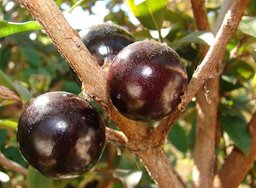 Fig. 17  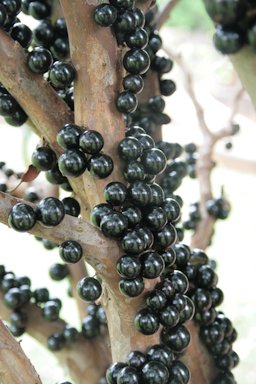 Fig. 18  Jaboticaba. Esta semana madurou. Agora é distribuir pra familia e amigos. 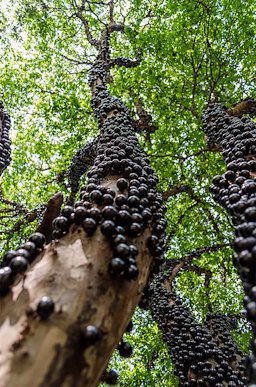 Fig. 19 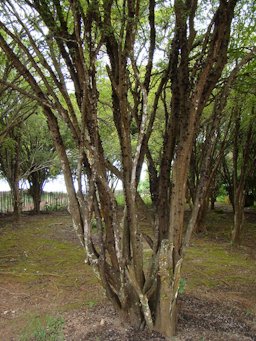 Fig. 28  Fruiting plant, growing in a home orchard 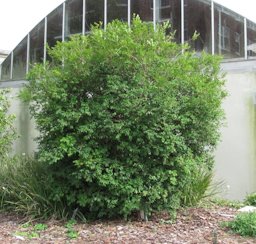 Fig. 29  Jaboticaba, M. cauliflora, Florida Southern College campus, 16 years old 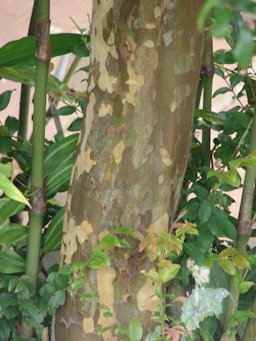 Fig. 30  M. cauliflora (Jaboticaba, Brazilian grape tree), trunk Makawao, Maui, Hawai'i 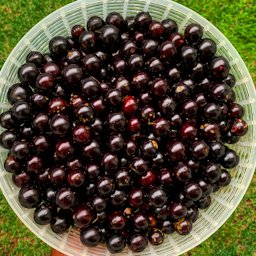 Fig. 31  M. cauliflora, Distrito Central, Francisco Morazan, Honduras 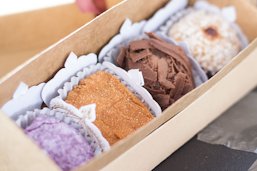 Fig. 32  João Brigadeiro Gourmet, Bombom de jabuticaba 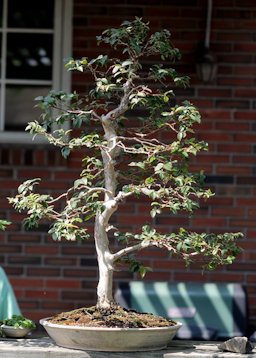 Fig. 33  Jaboticaba bonsai  Fig. 34  Ladrão de Jaboticaba |
Scientific
name Myrciaria cauliflora (Mart.) O.Berg. Pronunciation mer-see-AIR-ree-uh kawl-liff-FLOR-ruh 7 Common names English: Jaboticaba, Brazil grape tree, Brazilian grapetree; Argentina: iba-purú (Spanish); Bolivia: guapurú (Spanish); Brazil: jaboticaba, jaboticaba-de-sabará, jaboticaba sabará, jaboticabeira, jabuticaba, jabuticaba-açu, jabuticaba de campinas, jabuticaba-murta, jabuticaba-paulista, jabutica-ponhema, yabuticaba, (Portuguese); Paraguay: iba-purú (Spanish); Spanish: guapuru, hivapuru, iba-puru, jaboticaba, sabara, ybapuru, Yyabuticaba 1,16 Synonyms Plinia cauliflora (Mart.) Kausel; Eugenia cauliflora (Mart.); E. jaboticaba (Vell.) Kiaersk.; M. jaboticaba (Vell.) Baill.; M. jaboticaba (Vell.) O.Berg; Myrtus cauliflora Mart.; M. jaboticaba Vell. 8 Relatives Blue grape, M. vexator; cattley guava, Psidium cattleianum; cherry of the Rio Grande, Eugenia aggregata; feijoa, Feijoa sellowina; grumichama, E. braziliensis; guava, P. guajava; pitomba, E. luschnanthiana and Guava spp. 6 Family Myrtaceae (myrtle family) Origin Southern Brazil USDA hardiness zones 9b-11 Uses Edible fruit; small tree; shrub; hedge; bonsai 5 Height 15-30 ft (5-9 m) Spread 12-18 ft (3.5-5.5 m) Crown Dense, rounded; fine texture Plant habit Shrub or small, bushy tree; single or multi-trunked Growth rate Slow Longevity The tree may live for more than 150 years 6 Trunk/bark/branches Branches start low to the ground and slant outward; thin, beige to reddish bark flakes off much like that of the guava 1 Pruning requirement Not required Leaves Evergreen; young foliage/branchlets hairy; small; opposite; glossy dark green; leathery texture 1,9 Flowers White in profusion; insignificant; flowers intermittently year-round 5 Fruit Grape-like berry; round; 1/2-1 in. (1.27-2.54 cm); fleshy; black 7 Season Heaviest bearing in late March/April; mature tree can produce 100 pds over the season Light requirement Medium; high Soil tolerances Grows best on deep, rich, well-drained soil; have grown and borne well on sand oolitic limestone 9 pH preference 5.5-6.5 Drought tolerance No tolerance Soil salt tolerance No tolerance Cold tolerance Tolerates 26-29°F (-3.3- 1.7 °C) for a few hours in Florida 13 Plant spacing 30 ft (9 m) apart each way 9 Roots Compact, fibrous root system; transplants well 10 Invasive potential * Not a problem species (un-documented) Pest resistance Susceptible to aphids; scales; nematodes; spider mites 5 Known hazard Fruit skins contain tannins and should not be consumed in quantity 6 Reading Material Myrciaria cauliflora, University of Florida, Lee County pdf Jaboticaba, Fruits of Warm Climates Jaboticaba (Myrciaria cauliflora, berg.) a delicious fruit with an excellent market potential, Florida State Horticultural Society pdf Jaboticaba, University of Hawai'i at Mānoa pdf Jaboticaba, California Rare Fruit Growers The Jaboticaba, Manual Of Tropical And Subtropical Fruits The Myrtaceae or myrtle family comprises many genera of fruit trees and shrubs. Five of the most important are: Psidium, which includes the guava; Eugenia, with several species from America such as the Surinam cherry; Syzygium from Asia, which in-cludes the Malay apple; Feijoa or Acca; and Myrciaria, which includes the jaboticabas and other fruits. Cloves, allspice and eucalyptus are also in this family. The number of genera in the family has been reported as being from 130 to 150, with more than 5,600 species in tropical and warm temperate areas of the world. 18 Generally identified as Myrciaria cauliflora Berg. (syn. Eugenia cauliflora DC.), the names jaboticaba, jabuticaba or yabuticaba (for the fruit; jaboticabeira for the tree) actually embrace 4 species of very similar trees and fruits: M. cauliflora, sabará jaboticaba, also known as jabuticaba sabará, jabuticaba de Campinas, guapuru, guaperu, hivapuru, or ybapuru; M. jaboticaba Berg., great jaboticaba, also known as jaboticaba de Sao Paulo, jaboticaba do mato, jaboticaba batuba, jaboticaba grauda; M. tenella Berg., Jaboticaba macia, also known as guayabo colorado, cambui preto, murta do campo, camboinzinho; M. trunciflora Berg., long-stemmed jaboticaba, also called jaboticaba de Cabinho, or jaboticaba do Pará. 9 Origin M. cauliflora is native to the hilly region around Rio de Janeiro and Minas Gerais, Brazil, also around Santa Cruz, Bolivia, Asunción, Paraguay, and northeastern Argentina. 9 The jaboticaba has been distributed throughout the world and was introduced into California in 1904. It is found as an ornamental and backyard tree in Hawaii. Some production occurs and is used to make a wine on the Big Island of Hawaii. 15 Description The jaboticaba ranks as one of the most desirable species for dooryard planting, surpassing citrus in many respects. It is a sensational landscape spedimen, with peeling bark (Fig. 29) and a dense crown of lacy foliage. The fruit deserves equal praise. Aficionados consider the flavor to be the finest of any berry-type fruit. The tree bears profusely and repeatedly. The jaboticaba is highly recommended for planting in south florida and protected areas of central Florida. 6 Its habit of producing the fruit directly upon the trunk and larger limbs, together with the unusual beauty of its symmetrical and umbrageous head of pale green foliage, makes this a peculiarly striking tree. 12
Fig. 2 . M. cauliflora (Jaboticaba, Brazilian grape tree) habit, Keanae Arboretum, Maui, Hawai'i Fig. 3. I loved the trunk of this M. cauliflora, Brazilian Grape tree, at Lyon Arboretum on Oahu, Hawai'i Fig. 5. Bark at Keanae Arboretum, Maui, Hawai'i The Brazilians Are Coming! Edible South Florida Leaves The evergreen, opposite leaves, on very short, downy petioles, are lanceolate or elliptic, rounded at the base, sharply or bluntly pointed at the apex; 1 to 4 in (2.5-10 cm) long, 1/2 to 3/4 in (1.25-2 cm) in width. 9 The glossy leaves have a leathery texture and the new growth has a reddish or pinkish color (Fig. 3) that changes to pale yellowish-green before becoming dark green. 6,18
Flowers Spectacularly emerging from the multiple trunks and branches in groups of 4, on very short, thick pedicels, the flowers have 4 hairy, white petals and about 60 stamens to 1/6 in (4 mm) long. 9 Its flowers are staminous, cauliflorous, meaning they grow directly on the bark or underbark along the trunk, limbs and branches. This occurs several times a year primarily in late winter and spring. 5 Rain and overhead irrigation are harmful to fruit set during the first 3 days after bloom. Two days after they appear, the flowers begin to desiccate. From this point forward, fruit quality depends on the tree receiving a steady supply of water. 6
Pollination It has been reported from Brazil that solitary jaboticaba trees bear poorly compared with those planted in groups, which indicates that cross-pollination enhances productivity. 9 Bees are frequently seen visiting the flowers. 15 Fruit The fruit, borne in abundance, singly or in clusters, on short stalks, is largely hidden by the foliage and the shade of the canopy, but conspicuous on the lower portions of the trunks. Round, slightly oblate, broad-pyriform, or ellipsoid, with a small disk and vestiges of the 4 sepals at the apex, the fruits vary in size with the species and variety, ranging from 1/4 in (6 mm) in M. tenella and from 5/8 to 1 1/2 in (1.6-4 cm) in diameter in the other species. The smooth, tough skin is very glossy, bright-green, red-purple, maroon-purple, or so dark a purple as to appear nearly black, slightly acid and faintly spicy in taste; encloses a gelatinous, juicy, translucent, all-white or rose-tinted pulp that clings firmly to the seeds. The fruit has an overall subacid to sweet, grapelike flavor, mildly to disagreeably resinous, and is sometimes quite astringent. The fruit has been well likened to a muscadine grape except for the larger seeds. 9 The seeds are oval to nearly round measuring 3–10 mm, light brown colored, medium-hard to soft in texture and are usually swallowed with the pulp. Each seed has several embryos because of nucellar embryony. 18 Fruits are not produced on new growth as is common on many other tropical fruit trees. Fruit development is very rapid, usually 1 to 3 months, after flowering. 5,9 The fruit is non-climacteric thus it is harvested at full maturity to obtain the best flavor when the fruit is dark purple or almost black. 18
Fig. 20. Jaboticabas, ainda verdes, mais alguns dias e estarão deliciosas Fig. 23. Jabuticaba (M. cauliflora) fruits, Brazilian Grape tree, Guaperu, Guapuru, Hivapuru, Ybapuru, mother´s home, Sao paulo. Brazil Fig. 24. Jabotecaba, M. cauliflora, Myrtaceae fruiting habit Fig. 25. The Jaboticaba fruit is very tasty and interesting; this tree is in the backyard of the house of my parents and brings me a lot of sweet memories from my childhood Fig. 26. Jaboticabas do meu quintal Varieties Page Harvesting Fruit production may occur throughout the year but the heaviest bearing is in late March and April with hundreds of fruit on a large tree. A mature tree may produce 100 pounds of fruit over the course of a season. Yield is not always reliable and may vary form year to year. The fruit should be harvested a few days after maturity. The fruit spoils at room temperature in about two days. 5 One way of not handling the fruit too much is to hose the fruit while on the tree. Remains of old flower petals and leaves stick to the fruit, and hosing them down before picking removes all the debris. 4 Several methods are used for harvesting; one is to rub the fruit off the tree branch or pick them individually. Plant rubbing can be done with a broom or a stick so the fruit will drop to the ground. Putting a canvas under the canopy can help in gathering the fallen fruit. The use of a pipe with an end like a funnel and a hose at the other end can be practical with the rim of the funnel rubbing the fruit, which falls into it and rolls down the hose. The branches can also be shaken and ripe fruit will drop normally. Although the skin is tough careful handling is still recommended. 18 Each harvest season lasts about two weeks. 13 Propagation Jaboticabas are usually grown from seeds in South America. These are nearly always polyembryonic, producing 4 to 6 plants per seed. They germinate in 20 to 40 days. Selected strains can be reproduced by inarching (approach-grafting) or air-layering. Budding is not easily accomplished because of the thinness of the bark and hardness of the wood. Side-veneer grafting is fairly successful. Experimental work has shown that propagation by tissue culture may be feasible. 9 Production may begin in 4-15 years but usually 8 to 10 years from seed and about 6-7 years from vegetatively propagated. 13 Note: M. cauliflora produces apomictic, polyembryonic seeds where all seedlings are identical to the mother tree. 13 Pruning It is recommended to leave the first 80 cm of the trunk free of branches and then have three primary vertical branches and later clear excess wood. Production pruning consists of eliminating damaged branches or those overcrowding the canopy to improve light and air penetration. This pruning includes removing ex- cessively vertical interior branches or horizontal branches in older trees. Since fruit are borne on the main trunk and branches, overlapping crowns and hedging are not regarded as adversely impacting yield. Some pruning is sometimes prac- ticed to open up the tree to allow access to the center of the tree. Tree pruning increases the size of the remaining fruit. 18 Without pruning, the tree branches close to the ground and forms a fairly tight network of primary and secondary branches. 3 Fertilizing In high pH soils, some special attention may be required to provide the proper nutrition. Fertilize it three times a year with a complete fertilizer. Chelated iron can be applied to correct iron deficiency. Be sure other micronutrients are part of the fertilizer mix. 5 Irrigation Trees should be irrigated regularly during the dry months (November-May in Florida) if it does not rain. 13 Irrigation does promote flowering in the dry season and is recommended in Brazil to avoid flowering in the rainy season when rust can be a problem. 15 Pests The plant is not often bothered by pests. Aphids, scales, nematodes and spider mites are minor, occasional problems. 5 In Florida, raccoons and opossums make raids on jaboticabas. 9 Food Uses Squeezing the fruit between the thumb and forefinger causes the skin to rupture and the pulp to slip out for eating. 15 The skin is high in tannin and should not be consumed in large quantities over a long period of time. 1 Ripe jaboticaba fruits are highly nutritious and are mostly eaten as fresh fruit but are also processed to make juice, dry sweet wine, liquor, vinegar, sherbets, compotes, jam, jelly, tarts and marmalade with the addition of pectin. They can be preserved by freezing. 16 "I love to cut them in half and suck the white juicy sweet flesh away from the thick skin. The flesh tends to stick to the seed and if one is patient, one can eventually clean the seed smooth with tongue and teeth. Don loves popping them into his mouth, giving the fruit a munch and swallowing the seed, flesh and juice and then removing the skin." 4
Jaboticaba, Florida Food Fare, University of Florida pdf (archived) Medicinal Properties ** A decoction made from the sun-dried skins, which is astringent, is used in Brazil as treatment for asthma, diarrhea and dysentery and for chronic inflammation of the tonsils. 16 Attention should be given to excessive consumption of this decoction, which could lead to too much tannin in the body, which is carcinogenic if taken over a long period of time. 9 Other Uses Jaboticaba has become poular as bonsai plants in Taiwan and the Caribbean. 16 The wood is straight-grained, average texture, moderately heavy, but susceptible to wood-eating organisms. It is only used as a fuel and to make charcoal. 14 Prospects The jaboticaba is a delicious fruit indigenous to Brazil, Bolivia, Paraguay and Argentina. The fruit is highly esteemed and is commercially cultivated in large quantities in Brazil. Several factors favor its potential establishment in South Florida including the trees' adaptation to our humid subtropical climate, the large Brazilian population that has settled in Florida, and few pest problems. Brazilians are very familiar with the fruit and have high regard for it, thus providing the initial clientele needed for its commercial production. The main drawbacks for commercial production include: the trees slow grow rate, taking 5 to 7 years to begin production; the lack of superior cultivars; difficulty in picking the fruit and; trees are not well adapted to the highly calcareous, high pH soils in southern Miami-Dade County, thus requiring minor element applications. 13 General The name “jabuticaba” has indigenous origin and it comes from two words: “jabuti” (tortoise), which is the common name given to reptiles of genus Chelonoidis, order Chelonia, family Testudinidae; and “caba”, which means “place”, thus it means the place where one finds tortoises. This designation comes from the presence of these animals near jabuticaba trees; they feed on the fruits that fall to the ground. 17 The Guarani name is yvapurũ, where yva means fruit, and the onomatopoeic word purũ for the crunching sound the fruit produces when bitten. 11 Further Reading Subtropical Myrtaceae, Neglected Crops, Food and Agriculture Organization of the United Nations Jaboticaba, Archives of the Rare Fruit Council of Australia Further Information on the Jaboticaba, Archives of the Rare Fruit Council of Australia Jaboticabas, a New Crop to Look Out For, Archives of the Rare Fruit Council of Australia The Jaboticaba, Tropical Fruit News, RFCI Jaboticaba, Manatee County Master Gardening Bench Myrciaria cauliflora, University of Florida pdf (archived) The Jaboticaba, Unitversity of Florida pdf (archived) A Sweet Delight, the Jaboticaba, Archives of the Rare Fruit Council of Australia List of Growers and Vendors |
||||||||||||||||||||||||||||||||||
| Bibliography 1 "Jaboticaba." California Rare FruitGrowers, Fruit Facts, 1996, crfg.org. Accessed 15 Jan. 2015. 2 Love, Ken, and Robert E. Paull. "Jaboticaba." Hawaii Tropical Fruit Growers, Dept. of Tropical Plant and Soil Sciences, 2011, CTAHR, ctahr.hawaii.edu. Accessed 14 Jan. 2015. 3 "Jaboticaba." Archives of the Rare Fruit Council of Australia, . Article from EFGA Newsletter Aug. 1986, Sept. 1986. rfcarchives.org.au. Accessed 15 Jan. 2015. 4 Gray, Christine. "A Sweet Delight the Jaboticaba." Archives of the Rare Fruit Council of Australia, Jan. 1992, rfcarchives.org.au. Accessed 15 Jan. 2015. 5 Brown, Stephen H. "Myrciaria cauliflora Family: Myrtaceae. Jaboticaba; Brazilian grapetree; jabuticaba; ybapuru." UF/IFAS, Lee County Extension, Apr. 2011, AskIFAS, edis.ifas.ulf.edu. Accessed 15 Jan. 2015. 6 Boning, Charles R. Florida's Best Fruiting Plants- Native and Exotic Trees, Shrubs, and Vines. Sarasota, Pineapple Press, 2006. 7 Gilman, Edward F. "Myrciaria cauliflora." Environmental Horticulture Dept., UF/IFAS Extension Service, FPS-419, Original Pub. Oct. 1999, AskIFAS, edis.ifas.ulf.edu. Accessed 25 Jan. 2017. 8 "Plinia cauliflora (Mart.) Kausel synomyms." The Plant List (2013). Version 1.1, www.theplantlist.org. Accessed 25 Jan. 2017. 9 Fruits of Warm Climates. Julia F. Morton, Miami, 1987. 10 Barwick, Margaret. Tropical & Subtropical Trees. A Worldwide Encyclopaedic Guide. London, 2004. 11 "Jabuticaba." Wikipedia, wikipedia.org. Accessed 26 Jan. 2017. 12 Popenoe, Wilson. Manual Of Tropical And Subtropical Fruits. 1920, London, Hafner Press, 1974. 13 Balerdi, Carlos F., et al. "Jaboticaba (Myrciaria cauliflora, berg.) a delicious fruit with an excellent market potential." Proceedings of the Florida State Horticultural Society, Krome Memorial Institute (Tropicals), vol. 119, 2006, journals.flvc.org/fshs/article/view/86084. Accessed 6 Mar. 2022. 14 Lorenzi, Harri. Brazilian Trees, A Guide to the Identification and Cultivation of Brazilian Native Trees. Vol. 3. Nova Odessa, Instituto Plantarum de Estudos da Flora, 2009. 15 The Encyclopedia of Fruit & Nuts. Edited by Jules Janick and Robert E. Paull, Cambridge, CABI, 2008. 16 Lim T. K. "Edible Medicinal And Non-Medicinal Plants: Volume 3, Fruits." EPDF, 2012, epdf.pub/volume-3-fruits.html. Accessed 9 Mar. 2022. 17 Exotic Fruits, Reference Guide. Edited by S. Rodrigues, E. de Oliveira Silva and E. Sousa de Brito, London, Academic Press, 2018. 18 Duarte, Odilo and Robert E. Paull. Exotic Fruits and Nuts of the New World. Cambridge, CABI, 2015. Videos v1 "Tasty Tropical Treats, Jaboticaba (aka Brazilian Tree Grape)." Truly Tropical, 28 Mar. 2017, (CC0), www.youtube.com/watch?v=qlOoghRqi_c&list=PL2lELLdkvPuisplWxX3lcvwrQKj9fsB-T. Accessed 7 Mar. 2022. Photographs Fig. 1,9,16 "Myrciaria cauliflora, Plinia cauliflora, Eugenia cauliflora." Top Tropicals, toptropicals.org. Accessed 27 Jan. 2017. Fig. 2 Starr, Forest, and Kim. "Myrciaria cauliflora (Jaboticaba, Brazilian grape tree) Habit. Keanae Arboretum, Maui, Hawai'i." Starr Environmental, 2012, (CC BY 4.0), starrenvironmental.com. Accessed 25 Jan. 2017. Fig. 3 Cutler, Wendy. "I loved the trunk of this Myrciaria cauliflora, Brazilian Grape Tree, at Lyon Arboretum on Oahu." Flickr, 2010, (CC BY 2.0), flickr.com. Accessed 27 Jan. 2017. Fig. 4 Treeworld Wholesale. "Myrciaria Cauliflora (Jaboticaba Brazilian Grape Tree)." Flickr, 2016, (CC BY 2.0), flickr.com. Accessed 27 Jan. 2017. Fig. 5 Starr, Forest, and Kim. "Myrciaria Cauliflora (Jaboticaba Brazilian Grape Tree), Bark at Keanae Arboretum, Maui, Hawai'i." Flickr, 2012, (CC BY 2.0), flickr.com. Accessed 27 Jan. 2017. Fig. 6 Cody, Ben. "Leaves of the Plinia cauliflora." Wikimedia Commons, 2008, Public Domain, commons.wikimedia.org. Accessed 15 Jan. 2015. Fig. 7 Starr, Forest and Kim. Myrciaria cauliflora (Jaboticaba, Brazilian grape tree). Leaves. Makawao, Maui." Starr Environmental, 2009, (CC BY 4.0), starrenvironmental.com. Accessed 25 Jan. 2017. Fig. 8 Mateus302010. "Jabuticaba ramo baixo." Wikimedia Commons, 7 Aug. 2021, (CC BY-SA 4.0), commons.wikimedia.org/wiki/File:Jabuticaba_ramo_baixo.jpg. Accessed 7 Mar. 2022. Fig. 10 Oliveira, Cristiano. "Jabuticaba flowers - Side by Side, Brazil." Flickr, 22 Mar. 2010, (CC BY-NC 2.0), www.flickr.com/photos/olivcris/4458244127/. Accessed 6 Mar. 2022. Fig. 11,24 Love, Ken. "Jaboticaba, Myrciaria cauliflora, Myrtaceae." Botany Dept., Mānoa Campus Plants, University of Hawai'i, botany.hawaii.edu. Accessed 15 Jan. 2015. Fig. 12 Caetano, Marise. "Happy Quinta-flower! Jabuticaba - Myrciaria cauliflora. Fruit native to Brazil, bears stem berries, purple in color and absolutely delicious!" Flickr, 2012, (CC BY 2.0), flickr.com. Accessed 27 Jan. 2017. Fig. 13 RO, Sonia. "Baby jabuticabas." Flickr, 2008, (CC BY-NC-SA 2.0), flickr.com. Accessed 27 Jan. 2017. Fig. 14 Mauroguanandi. "Jabuticaba (Myrciaria cauliflora)." Flickr, 2009, (CC BY 2.0 ), flickr.com. Accessed 15 Jan. 2015. Fig. 15 Vitor.siaraujo. "Abelha extraindo néctar e pólen a partir de flores de jabuticaba. Foto capturada no município de Nova Era - MG." Wikimedia Commons, 30 Nov. 1999, (CC BY-SA 4.0), commons.wikimedia.org/wiki/File:Abelha_extraindo_matéria_prima.jpg. Accessed 7 Mar. 2022. Fig. 17 Campolina, Alexandre, Campola. "Jabuticaba ripe fruit." Wikimedia Commons, 2007, (CC BY 3.0), commons.wikimedia.org. Accessed 15 Jan. 2015. Fig. 18 Maximo, Gustavo. "Jaboticaba. Esta semana madurou. Agora é distribuir pra familia e amigos." Flickr, 2009, (CC BY-ND 2.0), flickr.com. Accessed 27 Jan. 2017. Fig. 19 Karklis, Bruno. "Fruta Jabuticaba Plinia cauliflora (syn. Myrciaria cauliflora)." Wikimedia Commons, 2012, (CC BY-SA 3.0), commons.wikimedia.org. Accessed 15 Jan. 2015. Fig. 20 Gorgônio, Kyller Costa. "Jaboticabas, ainda verdes. Mais alguns dias e estarão deliciosas." Flickr, 2010, (CC BY-NC-SA 2.0), flickr.com. Accessed 27 Jan. 2017. Fig. 21 Rovielo, Elias. "Jabuticabas." Flickr, 2013, (CC BY-NC-SA 2.0), flickr.com. Accessed 27 Jan. 2017. Fig. 22 guilhermedentista. "Jaboticaba." Pixabay, Public Domain, pixabay.com. Accessed 27 Jan. 2017. Fig. 23 Mauroguanandi. "Jabuticaba (Myrciaria cauliflora) fruits, Brazilian Grape Tree, Guaperu, Guapuru, Hivapuru, Ybapuru, mother´s home, Sao paulo. Brazilian native." Flickr, 2009, (CC BY 2.0), flickr.com. Accessed 27 Jan. 2017. Fig. 25 Fontes, Daniel Paixão. "The Jaboticaba fruit is very tasty and interesting. This tree is in the backyard of the house of my parents and bring me a lot of sweet memories from my childhood." Flickr, 2009, (CC BY 2.0), flickr.com. Accessed 27 Jan. 2017. Fig. 26 Remedios, Fernando. "Jaboticabas do meu quintal." Flickr, 2007, (CC BY-NC-SA 2.0), flickr.com. Accessed 27 Jan. 2017. Fig. 27 Setlik, Felipe. "Jabuticaba." Flickr, 2006, flickr.com. Accessed 15 Jan. 2015. Fig. 28 Mauroguanandi. "Jabuticaba (Myrciaria cauliflora)." Flickr, 2006, (CC BY 2.0 ), flickr.com. Accessed 27 Jan. 2017. Fig. 29 Manners, Malcolm. "Jaboticaba, Myrciaria cauliflora, Florida Southern College campus." Flickr, 28 Apr. 2010, (CC BY 2.0), Image cropped, flickr.com/photos/mmmavocado/4564056627/ . Accessed 6 Mar. 2022. Fig. 30 Starr, Forest, and Kim. "Myrciaria cauliflora (Jaboticaba, Brazilian grape tree) Trunk, Makawao, Maui." Starr Environmental, 2009, (CC BY 4.0), starrenvironmental.com. Accessed 15 Jan. 2015. Fig. 31 Kafie, Luis Jose. "Myrciaria cauliflora, Distrito Central, Francisco Morazan, Honduras." iNaturalist, Research Grade, 15 June 2020, (CC BY-NC 4.0), www.inaturalist.org/observations/49684063. Accessed 7 Mar. 2022. Fig. 32 Pontes, Romerito. "João Brigadeiro Gourmet - Ribeirão Preto - Bombom de jabuticaba." Flickr, 22 Nov. 2014, (CC BY 2.0), flickr.com/photos/36102864@N05/15684340807. Accessed 7 Mar. 2022. Fig. 33 Ross, Sage. "Jaboticaba." Flickr, 7 June 2008,, (CC BY-SA 2.0), flickr.com/photos/ragesoss/2559945150/. Accessed 6 Mar. 2022. Fig. 34 Barros, Felipe. "Ladrão de Jaboticaba." Flickr, 18 May 2008, (CC BY-NC-ND 2.0), Image cropped, flickr.com/photos/palms_trees/2637135208/in/photolist . Accessed 6 Mar. 2022. * UF/IFAS Assessment of Non-native Plants in Florida's Natural Areas ** Information provided is not intended to be used as a guide for treatment of medical conditions. Published 12 Apr. 2014 LR. Last update 10 Mar. 2022 LR |
|||||||||||||||||||||||||||||||||||




